Last week I was pointing out something to the men’s Bible study group that I am part of…Reformation churches are very Pauline, and so we tend to think of the gospel almost entirely in terms of faith and grace. It’s easy for us to forget that “faith” and “grace” were not religious terms when the Apostles started using them in the New Testament — the relationship between God and humans, being unique, is something for which there are not actually adequate words in any human language. When the Apostles tried to explain to new Christians how God thinks about us and feels about us and deals with us — how salvation and justification and sanctification all work — they had no choice but to pick ordinary words that would get them reasonably close, and then try to explain how God’s “grace” was different from the “grace” human beings ordinarily feel for each other, or how God’s “love” is not exactly like what we think of as “love” from our experience of loving each other. When Paul tried to explain this, the terms he found most useful were “faith” and “grace.”
But John did not find those words useful at all. He practically never uses them. Instead, even though he is trying to describe the same thing that Paul is, he uses an entirely different set of words — not because he disagrees with Paul, but because he has a different way of trying to explain the not-fully-explicable. For John, the key words are “love,” “truth,” “abide/remain,” and “commandment.”
In the following graphs I have shown the frequency with which various terms are used in different parts of the New Testament, which I have divided into the Synoptics (that is, Matthew, Mark and Luke), John’s Gospel, the Acts, the Pauline Epistles, the Catholic Epistles (meaning not letters written by Roman Catholics, but instead letters written to the Church Catholic, i.e., James, 1 and 2 Peter, and Jude), the Johannine Epistles (1, 2 and 3 John), and Revelation. The statistics are quoted in the number of usages per hundred pages.
I should say that the frequency with which words appear in the Johannine Epistles is exaggerated because the sample size is small; so while you should be impressed, you should perhaps be not quite as impressed as the graphs would naturally make you feel.
I will say that I was surprised to find that James, Peter and Jude talk about grace as enthusiastically as Paul does. At some point I will post an essay here about what the term “grace” meant to the first-century Christians who wrote and were intended to read the New Testament documents, and why the early church (except for John) found “grace” to be such an ideal word to express how God deals with us. For now, I will content myself with saying that either Paul took over the faith/grace idea set that Peter and James had already become accustomed to using heavily, or else all of the church except John was heavily influenced by Paul’s approach. I have a mild opinion that the latter is more likely. What is clear, at least, is that the Apostle John had his own way of thinking about and expressing the impact Jesus had had on his life and on the life of his “children” in the faith; and he seems to have remained serenely unaffected by the way the rest of the church talked.
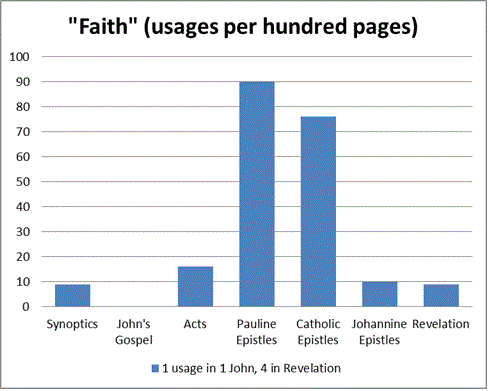
In this case I left out instances of the verb πιστεύειν (pisteuein, “believe”), because I was in a hurry and didn’t have time to distinguish between the sense of “believing a proposition” and “having faith.” The relationship between πιστεύειν pisteuein and πίστις (pistis, “faith”) is not nearly as straightforward as the relationship between ἀγαπᾷν (agapan, “to love”) and ἀγάπη (agape, “love”). And we would need to include the words for “faithful/trustworthy/believer,” “unfaithful/untrustworthy/unbeliever,” “lack faith / be unfaithful / fail to believe,” and distinguish between the theological and non-theological usages. So, quite a bit of work to be done.
The main thing to understand is that this graph is somewhat misleading (I will revise it later) because John does occasionally use the verb πιστεύειν pisteuein “believe in” and the various other words related to faith — he just practically never sees a need to use the term πίστις pistis “faith” itself.
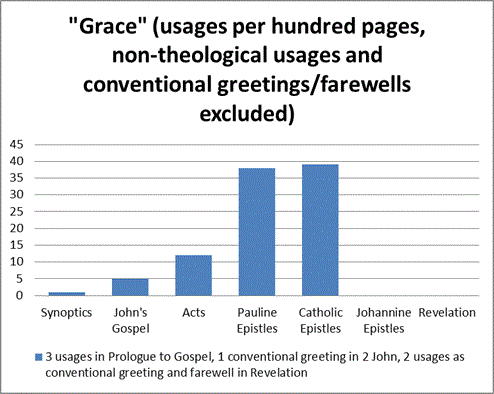
Paul and the rest of the Apostles’ generation found this term generally useful; the difference in how frequently they use it is insignificant given the small sample size of the Catholic Epistles. John uses it three times in the first chapter of his Gospel and then is done with it. (The opening “grace, mercy, and peace” in 2 John is a conventional greeting, as are the two usages in Revelation — sort of like the way we all use “Dear …” at the beginning of a letter, even to someone who is so much of a stranger to us that we don’t know whether to call the person “Sir” or “Madam.”)
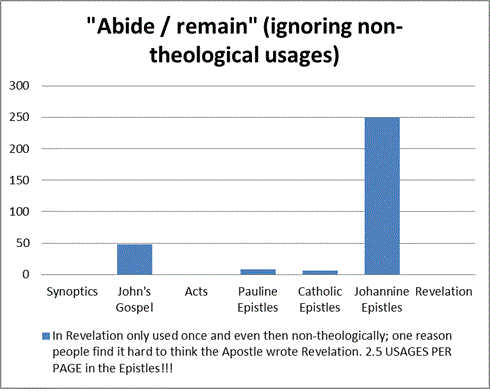
John really latched onto the idea of “abiding in Christ,” and it is central to his thought. It is at most an afterthought to all other NT writers.
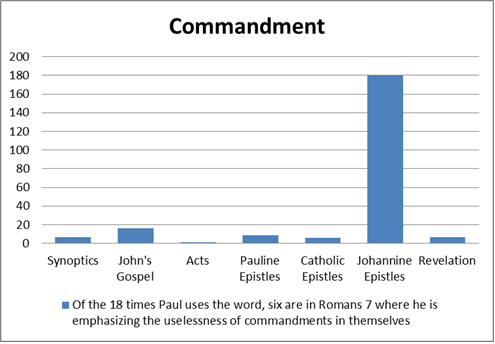
All NT writers agree that we should obey God’s commandments (though Paul does not think highly of their practical efficacy). To John, however, God’s commandments are at the core of the Christian experience…but then that’s probably because to John God’s commandments really come down to love, and love is really central to the Christian experience.
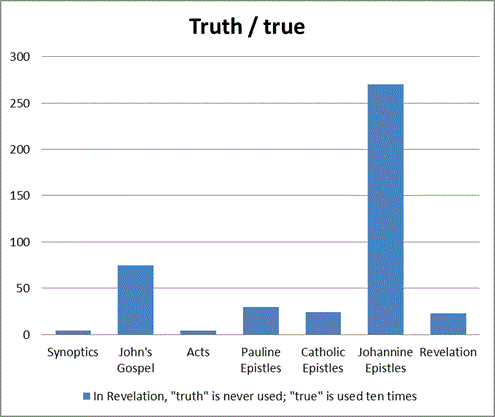
Obviously all NT writers think that Jesus brought us the truth. But…two and a half times a page in the Epistles…that’s a lot. Again, note that one of the reasons “truth” is so central to John’s thought is that he has more in mind than we usually think of when someone speaks of the “truth;” for John truth is a deeply practical, relational thing, so that one of his favorite phrases is “walking in the truth” — a phrase he uses where Paul would almost certainly say, “living in faith.”
But there’s no question what John’s favorite word is…
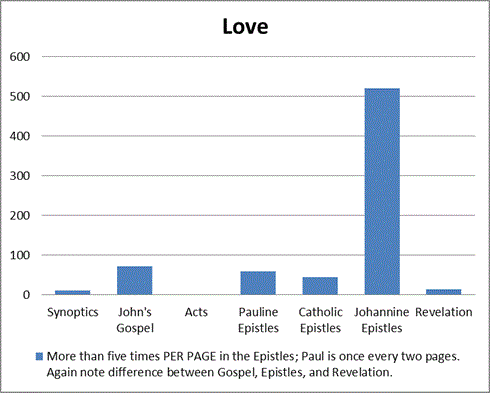
We know how important Paul thought love was; he proved that in 1 Corinthians 13. So how important is love to John? Important enough for him to use it almost ten times as frequently as Paul does!!
The thing about John isn’t that he has a few favorite words; every author does. What’s striking about John is that when he has a favorite word, it is a favorite; nobody else plays favorites with words the way he does. Here are the six terms all set side by side, each one with the person who uses them most frequently, and how much that person uses them.
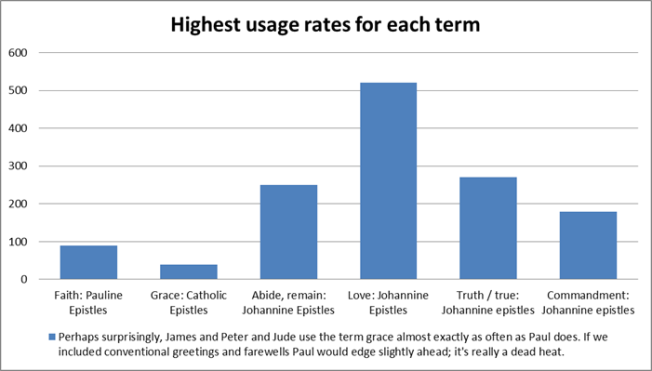
That’s right — John has four different words that he uses more often than Paul uses faith and grace added together.
And that’s why, if you’re going to read John, you’d better make sure you know exactly what he means when he talks about God’s commandment, about abiding and remaining, about truth, and most of all about love.